DARWIN, Charles Robert (1809-1882). On the Origin of Species by Means of Natural Selection . London: John Murray 1859. First edition of 'the most important single work in science' (Dibner), owned and read by two contemporaries of Darwin. 'A turning point, not only in the history of science, but in the history of ideas in general' (DSB). Although some key observations and findings from the voyage of the Beagle acted as his initial inspiration, Darwin's ideas about the beneficial mutation of species did not cohere into the theory of evolution until his reading of Thomas Malthus's Essay on the Principle of Population in the latter half of 1838. The gestation of the theory was slow, but in 1856, following a conversation with Sir Charles Lyell about his hypothesis, Darwin was determined to bring it to a conclusion. Two years later he had composed an extended treatise entitled 'Natural Selection', some two thirds complete at 250,000 words. Then in June 1858, Darwin received a letter about evolution from Alfred Russel Wallace, who had independently arrived at similar conclusions. The two scientists issued a joint paper on the subject at the Linnean Society on 1 July. Darwin was now forced to publish, and urged on by Hooker, he condensed his big book into an 'abstract' of some 155,000 words. 'The book, stripped of references and academic paraphernalia, was aimed not at the specialists, but directly at the reading public'. Finally published as On the Origin of Species on 24 November 1859 in a print run of 1250 copies, it expounded a theory of evolution that was recognisably superior and of infinitely greater impact than all previous hypotheses explaining biological diversity. The first owner of the book, Edward Turner Boyd Twisleton (1809-1874), was a British civil servant who moved in the same social circles as Charles Lyell, and both men knew the American scholar, George Ticknor In a letter to Ticknor dated 9 January 1860, Lyell comments: 'To return to Darwin's book, Twisleton ... told me he had been much taken with the new theory, and stated some objections' ( Life, Letters and Journals of Sir Charles Lyell, Bart, p.331). The second owner, Lawson Tait (1845-1899), was one of the world's leading gynaecological surgeons of the 19th century. However, the ODNB notes: 'While seeking the status of a gentleman surgeon and scientist, Tait was adept at making himself unpopular. In religion, he abandoned his parents' Catholicism and in Birmingham aligned with the nonconformist sects. In politics he adopted radical-Liberalism. His vigorous anti-vivisectionism infuriated associates of the Royal College of Surgeons and the British Association for the Advancement of Science. Tait's ardent ambition was to gain Charles Darwin's respect, and he had published a pamphlet entitled Has the Law of Natural Selection by Survival of the Fittest Failed in the Case of Man ? (1869). In 1871 Tait initiated a substantial sycophantic correspondence with Darwin. Darwin, however, was unimpressed with Tait's work as a natural historian and became annoyed when he realized that Tait was unwittingly replicating some of the work of the botanist Joseph Dalton Hooker Tait hoped to be elected a fellow of the Royal Society, but in 1876 Darwin informed him of his rejection.' Dibner Heralds (1980) 199; Eimas Heirs 1724; Freeman 373; Garrison-Morton (1991) 220; Grolier Science 23b; Norman 593; PMM 344b; Sparrow Milestones 49; Waller 10786. Octavo-in-12s (197 x 123mm). Half-tile, folding lithographic diagram. 32-page list of John Murray's books at end, dated June 1859 [Freeman's variant 2] (half-title and title with marginal vertical crease running approx. 25mm in from the fore-edge, 60mm tear into text but without loss on pp.7-8, pp.92-116 faintly creased at foot, very short marginal tear to first contents leaf, the first four leaves lightly frayed with tiny chipping at fore-edge, pp.321-2 with tiny marginal nick, a couple of leaves with faint insignificant marginal sta
DARWIN, Charles Robert (1809-1882). On the Origin of Species by Means of Natural Selection . London: John Murray 1859. First edition of 'the most important single work in science' (Dibner), owned and read by two contemporaries of Darwin. 'A turning point, not only in the history of science, but in the history of ideas in general' (DSB). Although some key observations and findings from the voyage of the Beagle acted as his initial inspiration, Darwin's ideas about the beneficial mutation of species did not cohere into the theory of evolution until his reading of Thomas Malthus's Essay on the Principle of Population in the latter half of 1838. The gestation of the theory was slow, but in 1856, following a conversation with Sir Charles Lyell about his hypothesis, Darwin was determined to bring it to a conclusion. Two years later he had composed an extended treatise entitled 'Natural Selection', some two thirds complete at 250,000 words. Then in June 1858, Darwin received a letter about evolution from Alfred Russel Wallace, who had independently arrived at similar conclusions. The two scientists issued a joint paper on the subject at the Linnean Society on 1 July. Darwin was now forced to publish, and urged on by Hooker, he condensed his big book into an 'abstract' of some 155,000 words. 'The book, stripped of references and academic paraphernalia, was aimed not at the specialists, but directly at the reading public'. Finally published as On the Origin of Species on 24 November 1859 in a print run of 1250 copies, it expounded a theory of evolution that was recognisably superior and of infinitely greater impact than all previous hypotheses explaining biological diversity. The first owner of the book, Edward Turner Boyd Twisleton (1809-1874), was a British civil servant who moved in the same social circles as Charles Lyell, and both men knew the American scholar, George Ticknor In a letter to Ticknor dated 9 January 1860, Lyell comments: 'To return to Darwin's book, Twisleton ... told me he had been much taken with the new theory, and stated some objections' ( Life, Letters and Journals of Sir Charles Lyell, Bart, p.331). The second owner, Lawson Tait (1845-1899), was one of the world's leading gynaecological surgeons of the 19th century. However, the ODNB notes: 'While seeking the status of a gentleman surgeon and scientist, Tait was adept at making himself unpopular. In religion, he abandoned his parents' Catholicism and in Birmingham aligned with the nonconformist sects. In politics he adopted radical-Liberalism. His vigorous anti-vivisectionism infuriated associates of the Royal College of Surgeons and the British Association for the Advancement of Science. Tait's ardent ambition was to gain Charles Darwin's respect, and he had published a pamphlet entitled Has the Law of Natural Selection by Survival of the Fittest Failed in the Case of Man ? (1869). In 1871 Tait initiated a substantial sycophantic correspondence with Darwin. Darwin, however, was unimpressed with Tait's work as a natural historian and became annoyed when he realized that Tait was unwittingly replicating some of the work of the botanist Joseph Dalton Hooker Tait hoped to be elected a fellow of the Royal Society, but in 1876 Darwin informed him of his rejection.' Dibner Heralds (1980) 199; Eimas Heirs 1724; Freeman 373; Garrison-Morton (1991) 220; Grolier Science 23b; Norman 593; PMM 344b; Sparrow Milestones 49; Waller 10786. Octavo-in-12s (197 x 123mm). Half-tile, folding lithographic diagram. 32-page list of John Murray's books at end, dated June 1859 [Freeman's variant 2] (half-title and title with marginal vertical crease running approx. 25mm in from the fore-edge, 60mm tear into text but without loss on pp.7-8, pp.92-116 faintly creased at foot, very short marginal tear to first contents leaf, the first four leaves lightly frayed with tiny chipping at fore-edge, pp.321-2 with tiny marginal nick, a couple of leaves with faint insignificant marginal sta
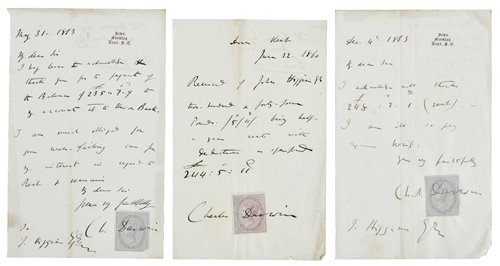
.jpg)



.jpg?w=400)
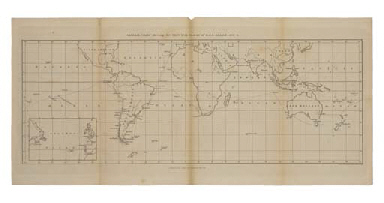
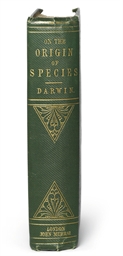
.jpg)
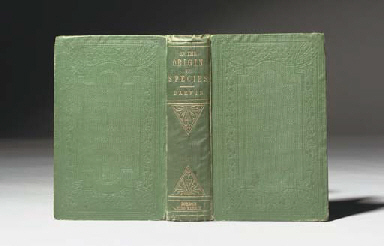
.jpg)
.jpg)
.jpg)
.jpg)
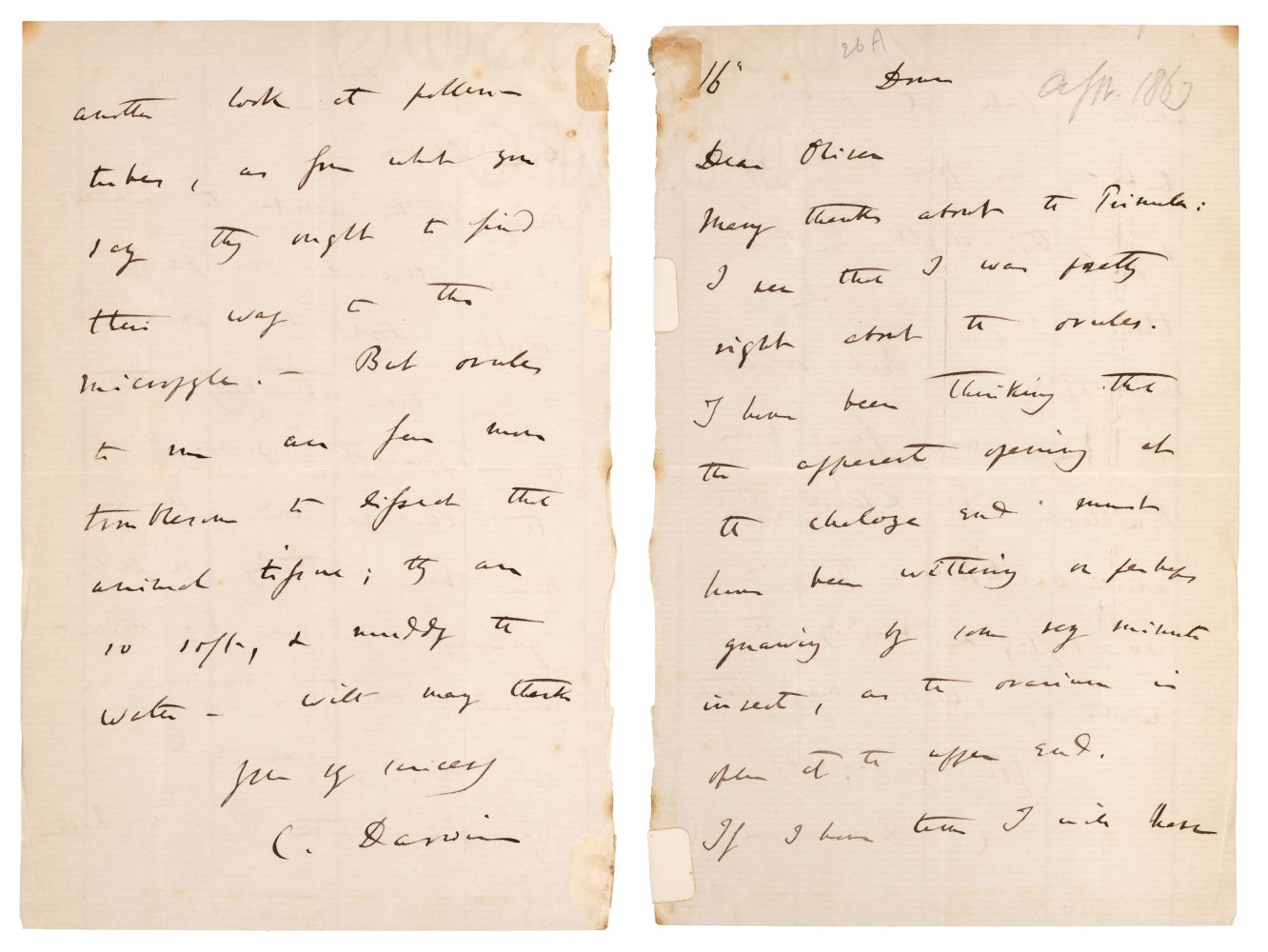
Try LotSearch and its premium features for 7 days - without any costs!
Be notified automatically about new items in upcoming auctions.
Create an alert